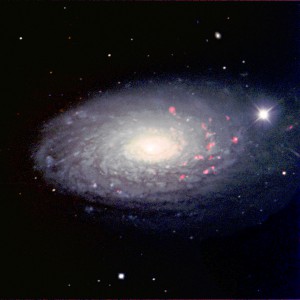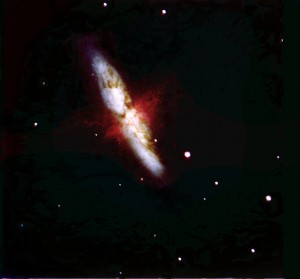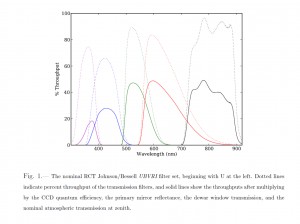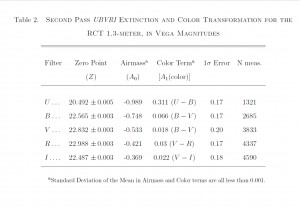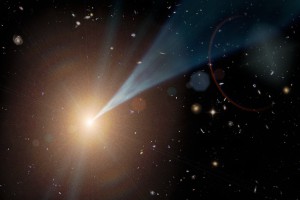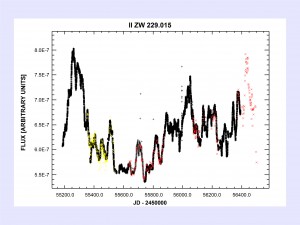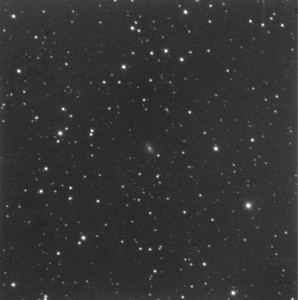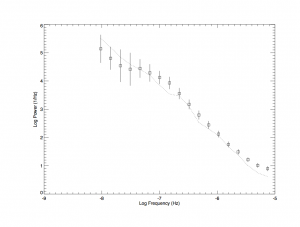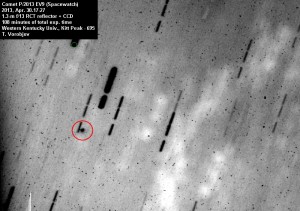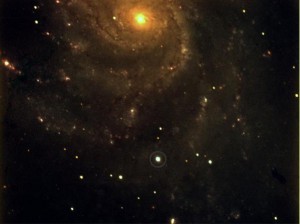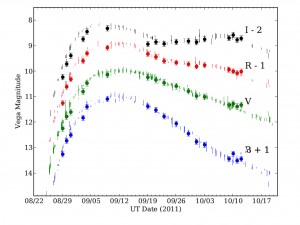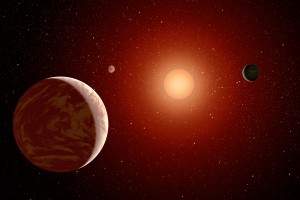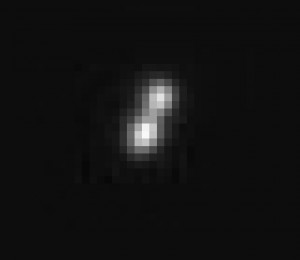Processed from BVRH-alpha RCT exposures taken in March, 2014. M63 is a well known LINER and there is some debate about the nature of the bright central source.
Author Archives: jbart
Preliminary RCT color image of M82 and SN 2014J
RCT PHOTOMETRIC CALIBRATIONS
ACTIVE GALAXIES
Blazars and other galaxies with active nuclei have been a significant focus of RCT research, as queue scheduled observations have facilitated monitoring the variable energy output of these sources. These data are then combined with observations by collaborators at other wavelengths, providing a clearer picture of the behavior of the material in the relativistic jet and central engine.
Composite light curve for the well-known AGN II ZW 229.015, showing data from the RCT (red), Barth et al. (2011, yellow), and the Kepler satellite. RCT image of II ZW 229.015 to the right taken on 06/05/2013.
The complete data set analyzed by Williams and Carini (2013) yields a break in the slope of the Power Spectrum Density (PSD) which implies a central black hole mass of 12 million solar masses, as shown in the above graph.
TRACKING COMETS AND ASTEROIDS
Comet P/2013 EV9 observed with the RCT on April 30, 2013. 54 120-second exposures were stacked to produce this composite. Click for sharper image.
Minor solar system bodies are a routine part of RCT observations, and results have appeared in numerous Minor Planet Circulars. Motions up to 3.5”/min. are readily tracked.
HUBBLE’S DISAPPEARING CEPHEID — THE STRANGE CASE OF M33 V19
In this post we summarize continuing efforts to monitor the strange behavior of M33 V19 in B and V using the RCT. With the ability of a robotic telescope to do time series observations, we hope to gain a better understanding of this ‘previously-a-Cepheid’ object’s unprecedented evolutionary behavior.
In 1926, Hubble determined the distance to M33 using 35 Cepheids he discovered, one of which was his Variable 19, with a period of 54.7 days, an amplitude in B of 1.1 mag, and a mean B magnitude of about 19.6. DIRECT project observations in 1996-7 with the 1.2m Whipple and 1.3m MDM telescopes and RCT observations, together with other data, clearly show that the star’s amplitude has diminished to less than 0.1 mag, while the star’s mean
brightness increased substantially.
Below is a another figure showing photometry of a fainter nearby Cepheid from both the RCT and the DIRECT project, showing that photometric quality is comparable.
MONITORING A SUPERNOVA IN M101
RCT observations of SN2011fe in M101 show the power of queue scheduled observations. The SN is circled in the above image. Diagram from Strolger et al. (2014, in press). RCT observations are shown as solid circles with error bars, while AAVSO observations are shown for comparison. Click for a sharper view of the figure below.
LIVING WITH A RED DWARF
EXOPLANET TRANSIT — TRES-1B OBSERVED SHORTLY AFTER DISCOVERY
Shortly after the Transatlantic Exoplanet Survey discovered a hot Jupiter (TRES-1B) transiting the K0V dwarf GSC 02652-01324 in 2004, the RCT was used to observe a transit, as shown in the diagram shown here. Scatter increased markedly over the time of observation as the airmass became large — typical transit observations at normal airmass will resemble the left side of the diagram.
The RCT is capable of detecting such transits reliably at least to the millimag level.
The end of peak oil
Oil (probably from the last days of the old compressor) was removed from the dewar window by Don Walter at the end of May. This has eliminated the curious-looking ‘coffee stain’ present on recent images.
The above unreduced image of Zw229-015 gives a fair idea of current image quality.
Current resolution with 2×2 binning (0.58 arcsec/pixel) is shown in this image of Eps Boo taken through the U filter. Separation is 2.85 arcsec.

